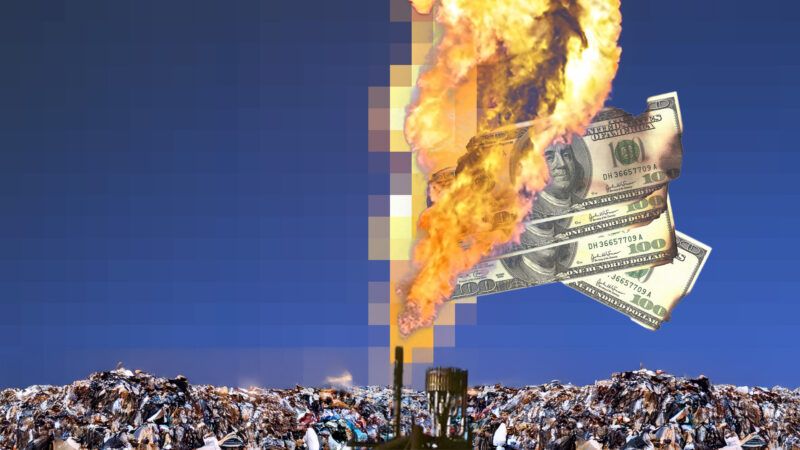Colorado Wants To Make Its Garbage Cleaner. A New Regulation Might Just Make It Pricier and Dirtier.
One rural county expects the regulation to cost its landfill almost $4 million up front, and an additional $1 million annually.

The average American household pays $300 to $900 per year on trash disposal services. For residents of Colorado, this bill might soon be much larger.
The Colorado Department of Public Health and Environment is considering a rule to clamp down on methane emissions from landfills, which are a significant contributor of the greenhouse gas (GHG) nationwide and the third-largest methane emitter in the state, behind the oil and gas industry and agriculture.
Last year, Colorado began requiring all landfills in the state to report their GHG emissions to the state's Department of Public Health and Environment. In April, the agency followed up on this rule by releasing Regulation 31, which requires landfills holding 450,000 tons of waste or more—the Environmental Protection Agency lists at least 28 such landfills in Colorado—to regularly monitor and report their methane emissions to state regulators. Those that emit between 732 tons and 2,000 tons of methane annually must conduct quarterly surface monitoring of their methane emissions. Those that emit more than 2,000 tons must conduct quarterly monitoring and install a gas collection and control system within 18 months.
These monitoring requirements could be difficult and expensive for operators to comply with. In Colorado's arid climate, the state may experience several consecutive months of dry weather before seeing a wetter month. These outlier months could spike a landfill's surface-level methane emissions past the regulation's threshold, which would force operators to install a gas collection and control system. These can cost up to $10 million. Garfield County, which has a population of about 64,000 people, says a such a system would cost the county landfill "roughly $4 million on the capital side, plus an additional $750,000 to $1 million to operate annually."
Regulation 31 also requires landfill operators to install organic biocovers, which cost between $60,000 and $80,000 per acre, and outlaws open flaring—which many landfills do as both a safety and environmental precaution—in most cases by 2029. For landfills that flare, facilities would need "to produce a certain amount of the gas to keep the flare burning, or else it would have to supply alternate fuels to keep it lit."
The stringent requirements of Regulation 31 will likely force landfills in the state to increase their tipping fees—Garfield County says it will need to at least double its charges. While larger landfills in more affluent and populated areas of the state will likely be able to survive the changes, these rate hikes could be a death knell for the smaller facilities in Colorado's rural counties. Even if they don't close, scaling back these facilities will require waste to be transported to larger landfills, which will likely cause more GHG emissions from diesel trucking and runaway pollution during transport. Deb Fiscus, the Garfield County landfill manager, said, "These regulations would create more emissions than they would reduce."
Other states that have implemented gas-capturing and methane-monitoring regulations have faced challenges with these rules. Some landfills in Oregon, which in 2021 passed more stringent regulations than what Colorado is considering, have been accused of not accurately measuring the emissions at large sections of their facilities. Taxpayers in Washington state have been forced to subsidize landfills as the state has awarded millions of dollars in grants to help waste facilities install gas-capturing systems. The state's Department of Ecology recently awarded funding to a facility in the state's wealthiest county.
A vote on Regulation 31 is expected to take place later this week. If the Department of Public Health and Environment moves forward, state regulators will surely herald it as a climate win. However, it could come at the expense of the state's residents and, ironically, the environment.


Show Comments (36)